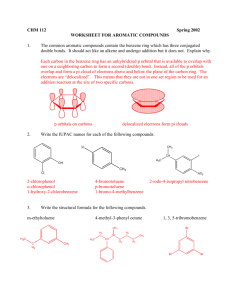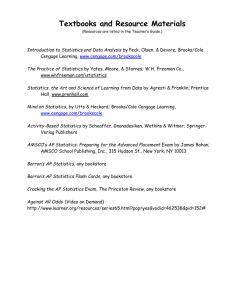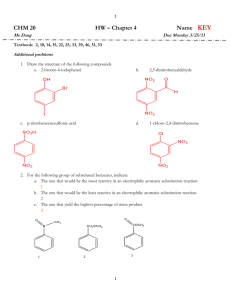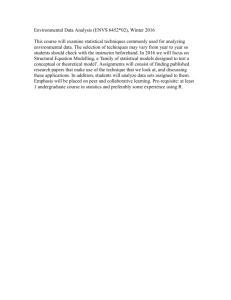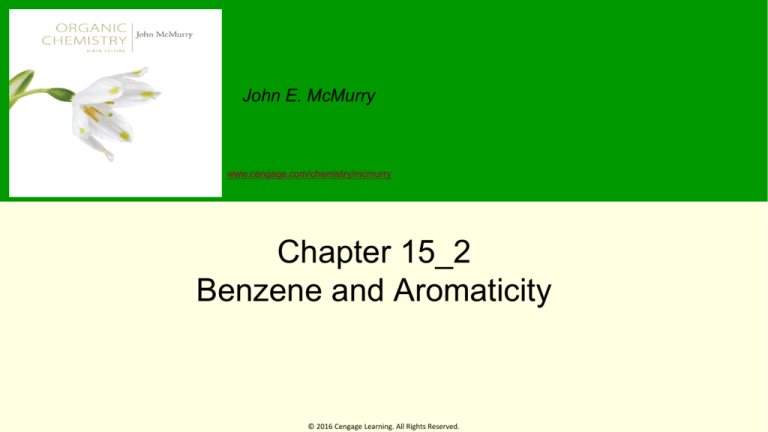
John E. McMurry
www.cengage.com/chemistry/mcmurry
Chapter 15_2
Benzene and Aromaticity
© 2016 Cengage Learning. All Rights Reserved.
Aromatic Ions
The 4n + 2 rule applies to ions as well as neutral substances
Both the cyclopentadienyl anion and the cycloheptatrienyl
cation are aromatic
© 2016 Cengage Learning. All Rights Reserved.
Figure 15.6 - Cyclopentadienyl Anion and
Cycloheptatrienyl Cation
© 2016 Cengage Learning. All Rights Reserved.
Aromatic Ions
When one hydrogen is removed from the
saturated CH2 in an aromatic ion, rehybridization
of the carbon from sp3 to sp2 would result in a
fully conjugated product with a p orbital on every
product
Methods to remove the hydrogen molecule
Removing the hydrogen with both electrons (H:–)
from the C–H bond results in a carbocation
Removing the hydrogen with one electron (H·)
from the C–H bond results in a carbon radical
Removing the hydrogen without any electrons
(H+) from the C–H bond results in a carbanion
© 2016 Cengage Learning. All Rights Reserved.
Aromaticity of Cyclopentadienyl Anion
Disadvantages of the four--electron cyclopentadienyl cation
and the five--cyclopentadienyl radical
Highly reactive
Difficult to prepare
Not stable enough for aromatic systems
Advantages of using the six--electron cyclopentadienyl anion
Easily prepared
Extremely stable
© 2016 Cengage Learning. All Rights Reserved.
Figure 15.7 - The Aromatic Cyclopentadienyl Anion and the
Aromatic Cycloheptatrienyl Cation
© 2016 Cengage Learning. All Rights Reserved.
Aromatic Heterocycles: Pyridine and
Pyrrole
Heterocycle: Cyclic compound that comprises atoms of two or
more elements in its ring
Carbon along with nitrogen, oxygen, or sulfur
Aromatic compounds can have elements other than carbon in the
ring
© 2016 Cengage Learning. All Rights Reserved.
Pyridine
Six-membered heterocycle with a nitrogen atom in its ring
electron structure resembles benzene (6 electrons)
The nitrogen lone pair electrons are not part of the aromatic
system (perpendicular orbital)
Pyridine is a relatively weak base compared to normal amines but
protonation does not affect aromaticity
© 2016 Cengage Learning. All Rights Reserved.
Figure 15.8 - Pyridine and Pyrimidine
© 2016 Cengage Learning. All Rights Reserved.
Pyridine and Pyrimidine
The structure of pyridine is quite similar to that of benzene
All five sp2-hybridized ions possess a p orbital perpendicular with
one to the plane of the ring
Each p orbital comprises one electron
The nitrogen atom is also sp2-hybridized and possesses one
electron in a p orbital
Pyrimidine comprises two nitrogen atoms in a six-membered,
unsaturated ring
The sp2-hybridized nitrogen atoms share an electron each to the
aromatic system
© 2016 Cengage Learning. All Rights Reserved.
Figure 15.9 - Pyrrole and Imidazole
© 2016 Cengage Learning. All Rights Reserved.
Rings of Pyrimidine and Imidazole
Significant in biological chemistry
Pyrimidine is the parent ring system present in cytosine, thymine,
and uracil
Histidine contains an aromatic imidazole ring
© 2016 Cengage Learning. All Rights Reserved.
Polycyclic Aromatic Compounds
While the Hückel rule is relevant only to monocyclic
compounds, the concept of aromaticity can also be applied to
polycyclic aromatic compounds
© 2016 Cengage Learning. All Rights Reserved.
Naphthalene Orbitals
Three resonance forms and delocalized electrons
Naphthalene and other polycyclic aromatic hydrocarbons possess
certain chemical properties that correspond to aromaticity
Heat of hydrogenation in naphthalene is approximately 250 kJ/mol
© 2016 Cengage Learning. All Rights Reserved.
Aromaticity of Naphthalene
Naphthalene possesses a cyclic, conjugated electron system
p orbital overlap is present along the ten-carbon periphery of the
molecule and across the central bond
Aromaticity is due to the electron delocalization caused by the
presence of ten electrons (Hückel number)
© 2016 Cengage Learning. All Rights Reserved.
Heterocyclic Analogs of Naphthelene
Quinolone, isoquinolone, and purine have pyridine-like
nitrogens that share one electron
Indole and purine have pyrrole-like nitrogens that share two
electrons
© 2016 Cengage Learning. All Rights Reserved.
Spectroscopy of Aromatic Compounds
Infrared Spectroscopy
C–H stretching absorption is seen at 3030 cm–1
Usually of low intensity
A series of peaks are present between 1450 and
1600 cm–1
Caused by the complex molecular motions of the ring
© 2016 Cengage Learning. All Rights Reserved.
Ultraviolet Spectroscopy
Presence of a
conjugated system
makes ultraviolet
spectroscopy possible
Intense absorption
occurs near 205 nm
Less intense absorption
occurs between 255 nm
and 275 nm
© 2016 Cengage Learning. All Rights Reserved.
Nuclear Magnetic Resonance
Spectroscopy
The aromatic ring shields hydrogens
Absorption occurs between 6.5 and 8.5 δ
The ring current is responsible for the difference in chemical shift
between aromatic and vinylic protons
Ring current is the magnetic field caused by the circulation of
delocalized electrons when the aromatic ring is perpendicular to
a strong magnetic field
The effective magnetic field is greater than the applied field
© 2016 Cengage Learning. All Rights Reserved.
Figure 15.13 - The Origin of Aromatic Ring
Current
© 2016 Cengage Learning. All Rights Reserved.
Nuclear Magnetic Resonance
Spectroscopy
Aromatic protons appear as two doublets at 7.04 and 7.37 δ
Benzylic methyl protons appear as a sharp singlet at 2.26 δ
© 2016 Cengage Learning. All Rights Reserved.
13C
NMR of Aromatic Compounds
Carbons in aromatic ring absorb between 110 and 140 δ
Shift is distinct from alkane carbons but in same range as
alkene carbons
© 2016 Cengage Learning. All Rights Reserved.
13C
NMR of Aromatic Compounds
The mode of substitution influences the formation of two, three, or
four resonances in the proton-decoupled 13C NMR spectrum
© 2016 Cengage Learning. All Rights Reserved.
Figure 15.16 - The Proton-Decoupled 13C NMR Spectra
of the Three Isomers of Dichlorobenzene
© 2016 Cengage Learning. All Rights Reserved.
Summary
The term aromatic refers to the class of compounds that are
structurally similar to benzene
Apart from IUPAC terms, disubstituted benzenes are also called
ortho, meta, or para derivatives
The C6H5 unit is called a phenyl group
The C6H5CH2 unit is called a benzyl group
The Hückel rule states that in order to be aromatic, a molecule
must possess 4n + 2 electrons, where InI = 0,1,2,3, and so on
© 2016 Cengage Learning. All Rights Reserved.
Summary
Planar, cyclic, conjugated molecules with other numbers of
electrons are antiaromatic
Pyridine and pyrimidine are six-membered, nitrogen containing,
aromatic heterocycles
© 2016 Cengage Learning. All Rights Reserved.

